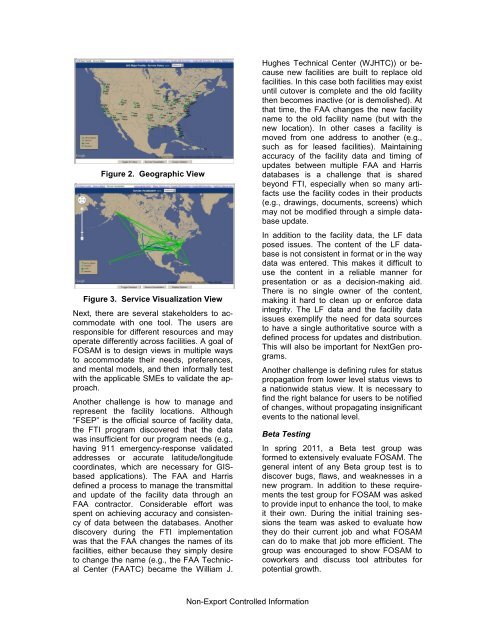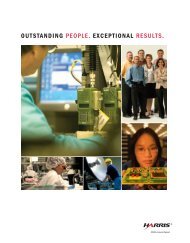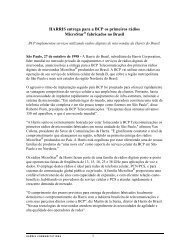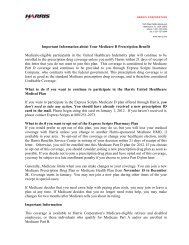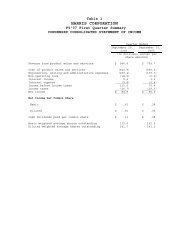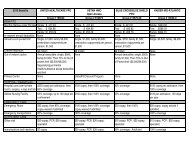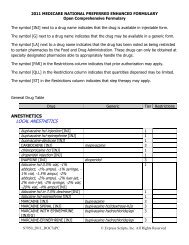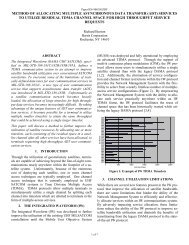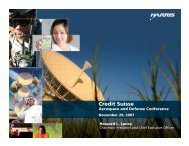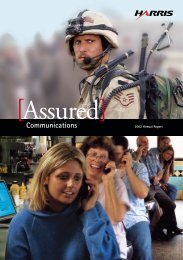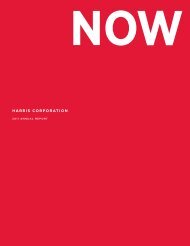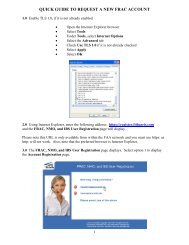Advancing Situational Awareness for Technical Operations
Advancing Situational Awareness for Technical Operations
Advancing Situational Awareness for Technical Operations
Create successful ePaper yourself
Turn your PDF publications into a flip-book with our unique Google optimized e-Paper software.
Figure 2. Geographic View<br />
Figure 3. Service Visualization View<br />
Next, there are several stakeholders to accommodate<br />
with one tool. The users are<br />
responsible <strong>for</strong> different resources and may<br />
operate differently across facilities. A goal of<br />
FOSAM is to design views in multiple ways<br />
to accommodate their needs, preferences,<br />
and mental models, and then in<strong>for</strong>mally test<br />
with the applicable SMEs to validate the approach.<br />
Another challenge is how to manage and<br />
represent the facility locations. Although<br />
“FSEP” is the official source of facility data,<br />
the FTI program discovered that the data<br />
was insufficient <strong>for</strong> our program needs (e.g.,<br />
having 911 emergency-response validated<br />
addresses or accurate latitude/longitude<br />
coordinates, which are necessary <strong>for</strong> GISbased<br />
applications). The FAA and Harris<br />
defined a process to manage the transmittal<br />
and update of the facility data through an<br />
FAA contractor. Considerable ef<strong>for</strong>t was<br />
spent on achieving accuracy and consistency<br />
of data between the databases. Another<br />
discovery during the FTI implementation<br />
was that the FAA changes the names of its<br />
facilities, either because they simply desire<br />
to change the name (e.g., the FAA <strong>Technical</strong><br />
Center (FAATC) became the William J.<br />
Non-Export Controlled In<strong>for</strong>mation<br />
Hughes <strong>Technical</strong> Center (WJHTC)) or because<br />
new facilities are built to replace old<br />
facilities. In this case both facilities may exist<br />
until cutover is complete and the old facility<br />
then becomes inactive (or is demolished). At<br />
that time, the FAA changes the new facility<br />
name to the old facility name (but with the<br />
new location). In other cases a facility is<br />
moved from one address to another (e.g.,<br />
such as <strong>for</strong> leased facilities). Maintaining<br />
accuracy of the facility data and timing of<br />
updates between multiple FAA and Harris<br />
databases is a challenge that is shared<br />
beyond FTI, especially when so many artifacts<br />
use the facility codes in their products<br />
(e.g., drawings, documents, screens) which<br />
may not be modified through a simple database<br />
update.<br />
In addition to the facility data, the LF data<br />
posed issues. The content of the LF database<br />
is not consistent in <strong>for</strong>mat or in the way<br />
data was entered. This makes it difficult to<br />
use the content in a reliable manner <strong>for</strong><br />
presentation or as a decision-making aid.<br />
There is no single owner of the content,<br />
making it hard to clean up or en<strong>for</strong>ce data<br />
integrity. The LF data and the facility data<br />
issues exemplify the need <strong>for</strong> data sources<br />
to have a single authoritative source with a<br />
defined process <strong>for</strong> updates and distribution.<br />
This will also be important <strong>for</strong> NextGen programs.<br />
Another challenge is defining rules <strong>for</strong> status<br />
propagation from lower level status views to<br />
a nationwide status view. It is necessary to<br />
find the right balance <strong>for</strong> users to be notified<br />
of changes, without propagating insignificant<br />
events to the national level.<br />
Beta Testing<br />
In spring 2011, a Beta test group was<br />
<strong>for</strong>med to extensively evaluate FOSAM. The<br />
general intent of any Beta group test is to<br />
discover bugs, flaws, and weaknesses in a<br />
new program. In addition to these requirements<br />
the test group <strong>for</strong> FOSAM was asked<br />
to provide input to enhance the tool, to make<br />
it their own. During the initial training sessions<br />
the team was asked to evaluate how<br />
they do their current job and what FOSAM<br />
can do to make that job more efficient. The<br />
group was encouraged to show FOSAM to<br />
coworkers and discuss tool attributes <strong>for</strong><br />
potential growth.


